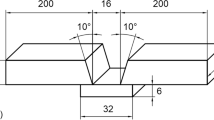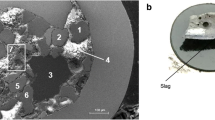Abstract
The behaviour of the weld characteristic of flux-cored wires is strongly influenced by the flux. The weld metal and weldability are determined by the flux composition and to a much smaller level by shielding gas used as well. The wide variety of components combined with the complexity of the welding process result in intricate mechanisms occurring in the slag. The slags of the different rutile flux-cored wires, designed for either position or standard downhand welding, were analysed in order to gain knowledge about the complex slag mechanisms and to carry out a metallurgical characterisation. Chemical analysis, differential thermal analysis and microstructural investigations of the slags were conducted to identify and characterise the formed phases. In addition, the viscosities of the slags were measured and correlated with the DTA results.



























Similar content being viewed by others
References
Strassburg F W, Wehner H, Schweißen nichtrostender Stähle, 4., überarb. u. erw. Aufl., DVS-Vlg, Düsseldorf, 2008
Mills KC, Yuan L, Jones RT (2011) Estimating the physical properties of slags. J South Afr Inst Min Metall 111(10):649–658
Verein Deutscher Eisenhüttenleute (VDEh) (1995) Slag atlas, 2nd edn. Verlag Stahleisen, Düsseldorf
Mysen BO (1988) Structure and properties of silicate melts. Elsevier, Amsterdam
Santhy K, Sowmya A, Sankaranarayanan SR (2005) Effect of oxygen to silicon ratio on the viscosity of metallurgical slags. ISIJ Int 45(7):1014–1018
ISO 11357-2 (2013) Plastics – differential scanning calorimetry – part 2: determination of glass transition temperature. https://www.iso.org/standard/57966.html
Verein Deutscher Eisenhüttenleute (VDEh), Ausschuss für Metallurgische Grundlagen (1981) Slag atlas. Verlag Stahleisen, Düsseldorf
Flood H, Förland T (1947) The acidic and basic properties of oxides. Acta Chem Scand 1:592–604
Kekkonen M, Oghbasilasie H, Louhenkilpi S (2012) Viscosity models for molten slags, research report, Aalto University. Helsinki, Finland https://aaltodoc.aalto.fi/bitstream/handle/123456789/3640/isbn9789526046037.pdf?sequence=1&isAllowed=y
Urbain G, Cambier F, Deletter M, Anseau MR (1981) Viscosity of silicate melts. Trans J Br Ceram Soc 80(4):139
Bauné E, Bonnet C, Liu S (2000) Reconsidering the basicity of a FCAW consumable-part 1: solidified slag composition of a FCAW consumable as a basicity indicator. Weld J 79(3):57s–65s
Mills K (2011) The estimation of slag properties: short course presented as part of Southern African Pyrometallurgy, http://www.pyrometallurgy.co.za/KenMills/index.html, Abgerufen am: 04.08.2016
Schwemmer DD, Olson DL, Williamson DL (1979) The relationship of weld penetration to the welding flux. Weld J 58(5):153s–160s
Herasymenko P (1938) Electrochemical theory of slag-metal equilibria. Part I.—reactions of manganese and silicon in acid open-heart furnace. Trans Faraday Soc 34(0):1245–1254
Sohn I, Wang W, Matsuura H, Tsukihashi F, Min DJ (2012) Influence of TiO2 on the viscous behavior of calcium silicate melts containing 17 mass% Al2O3 and 10 mass% MgO. ISIJ Int 52(1):158–160
Mysen B, Neuville D (1995) Effect of temperature and TiO2 content on the structure of Na2Si2O5-Na2Ti2O5 melts and glasses. Geochim Cosmochim Acta 59(2):325–342
Mills K, Guo M (2014) The importance of materials properties in high-temperature processes. ISIJ Int 54(9):2000–2007
Kondratiev A, Jak E, Hayes PC (2002) Predicting slag viscosities in metallurgical systems. JOM 54(11):41–45
Mills KC (1993) The influence of structure on the physico-chemical properties of slags. ISIJ Int 33(1):148–155
Iida T, Sakai H, Kita Y, Shigeno K (2000) An equation for accurate prediction of the viscosities of blast furnace type slags from chemical composition. ISIJ Int 40(Suppl):S110–S114
Mills KC, Sridhar S (2013) Viscosities of ironmaking and steelmaking slags. Ironmak Steelmak 26(4):262–268
Zhang S, Zhang X, Peng H, Wen L, Qiu G, Hu M, Bai C (2014) Structure analysis of CaO–SiO2–Al2O3–TiO2 slag by molecular dynamics simulation and FT-IR spectroscopy. ISIJ Int 54(4):734–742
Angell CA, Sichina W (1976) Thermodynamics of the glass transition: empirical aspects. Ann N Y Acad Sci 279(1 The Glass Tra):53–67
Presoly P, Pierer R, Bernhard C (2012) Linking up of HT-LSCM and DSC measurements to characterize phase diagrams of steels. IOP Conf Ser: Mater Sci Eng 33:1–9
Urbain G (1987) Viscosity estimation of slags. Steel Res 58(3):111–116
Funding
The authors gratefully acknowledge financial support from the K1-MET GmbH Metallurgical Competence Centre. The research program of the K1-MET Competence Centre is supported by COMET (Competence Centre for Excellent Technologies), the Austrian program for competence centres. COMET is funded by the Federal Ministry for Transport, Innovation, and Technology, the Federal Ministry for Science, Research and Economy, the provinces of Upper Austria, Tyrol, and Styria as well as the Styrian Business Promotion Agency (SFG).
Author information
Authors and Affiliations
Corresponding author
Additional information
Recommended for publication by Commission IX - Behaviour of Metals Subjected to Welding
Rights and permissions
About this article
Cite this article
Holly, S., Mayer, P., Bernhard, C. et al. Slag characterisation of 308L-type stainless steel rutile flux-cored wires. Weld World 63, 293–311 (2019). https://doi.org/10.1007/s40194-018-0675-6
Received:
Accepted:
Published:
Issue Date:
DOI: https://doi.org/10.1007/s40194-018-0675-6




